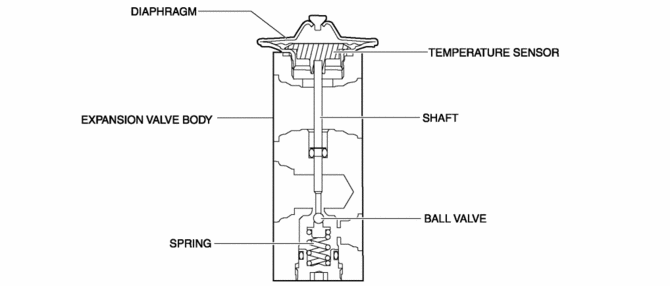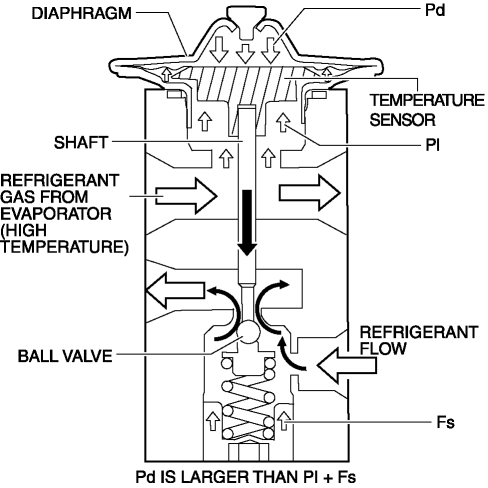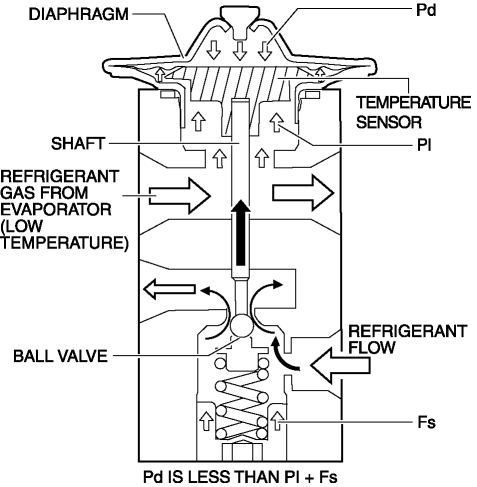Mazda CX-5 Service & Repair Manual: Expansion Valve
Purpose
-
The expansion valve atomizes liquid refrigerant to facilitate cooling of the evaporator.
Function
-
The expansion valve reduces the pressure of liquid refrigerant rapidly to facilitate vaporization of the atomized refrigerant at the evaporator, and adjusts the refrigerant amount sent into the evaporator.
Construction
-
The expansion valve consists of the following parts:
-
Diaphragm
-
Temperature sensor
-
Shaft
-
Expansion valve body
-
Ball valve
-
Spring

Operation
-
Adjustment of the refrigerant amount supplied to the evaporator is performed by the ball valve opening angle in the expansion valve.
-
The opening angle adjustment is performed according to the balance of the following forces:

-
Refrigerant pressure (Pd) in diaphragm
-
Refrigerant gas pressure (PI) of evaporator under diaphragm
-
Spring force (Fs) pushing up ball valve
-
If the refrigerant gas temperature from the evaporator increases, the expansion valve increases the amount of refrigerant according to the following operations:

-
The temperature of the temperature sensor tightly sealed against the diaphragm increases.
-
The refrigerant in the diaphragm warms and the Pd increases.
-
If this Pd increases more than PI + Fs, the diaphragm is pressed down.
-
The shaft installed to the temperature sensor end presses down the ball valve.
-
The amount of refrigerant is increased.
-
If the refrigerant gas temperature from the evaporator decreases, the expansion valve decreases the amount of refrigerant flow according to the following operation:

-
The temperature of the temperature sensor tightly sealed against the diaphragm decreases.
-
The refrigerant temperature in the diaphragm decreases and the Pd decreases.
-
The Pd decreases less than PI + Fs.
-
The ball valve installed to the temperature sensor end is pressed up.
-
The amount of refrigerant is decreased.
Fail-safe
-
Function not equipped.
 Evaporator Inspection
Evaporator Inspection
1. Inspect the evaporator for damage, cracks, and oil leakage.
If there is any malfunction, replace the evaporator.
2. Visually inspect the fins for bending.
If there is any bend ...
 Expansion Valve Removal/Installation
Expansion Valve Removal/Installation
1. Disconnect the negative battery cable..
2. Discharge the refrigerant from the system..
CAUTION:
If moisture or foreign material enters the refrigeration cycle, cooling ability
will b ...
Other materials:
Clock Spring Removal/Installation [Standard Deployment Control System]
CAUTION:
If the disc on the combination switch is deformed or has foreign material
adhering to it, performance of the steering angle sensor may be reduced, causing
abnormal operation. When handling the clock spring, be careful not to deform
the disc and make sure there is no foreign ...
Intake Manifold Vacuum Inspection
1. Disconnect the evaporative hose No.3 (purge solenoid valve side) and install
the vacuum gauge..
2. Verify that the intake air hoses are installed securely.
3. Warm up the engine.
4. Measure the intake manifold vacuum while idling (no load) using the vacuum
gauge.
If not within t ...
Rear Brake (Disc) Removal/Installation
1. Loosen the adjusting nut..
2. Remove in the order indicated in the table.
3. Install in the reverse order of removal.
4. After installation, add brake fluid, bleed the air, and inspect for fluid
leakage..
5. Pump the brake pedal a few times and inspect the following:
The disc pa ...
